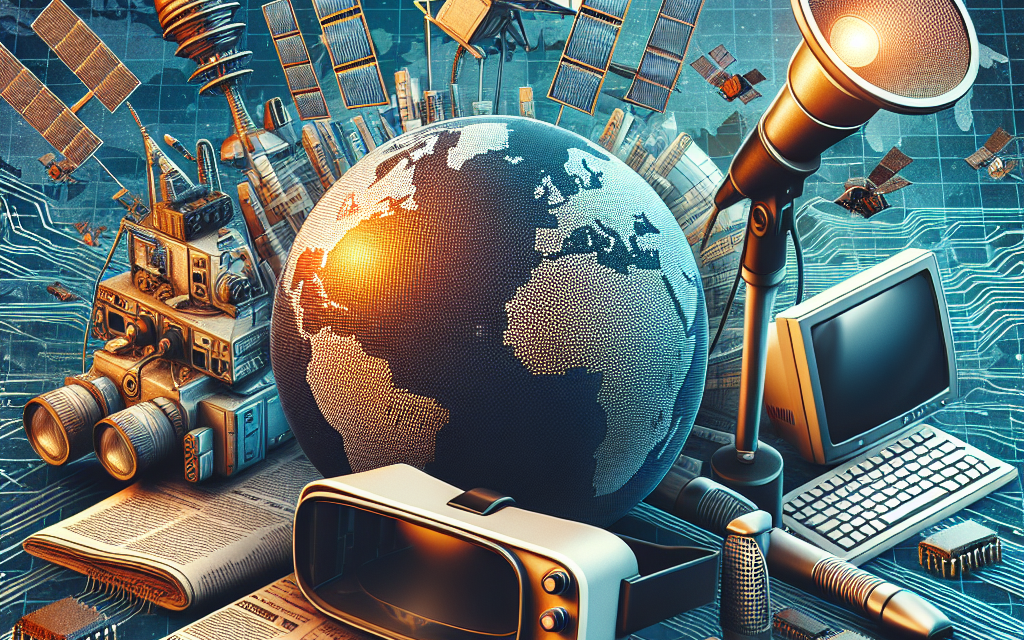“Unlocking Tomorrow: Essential Insights for Tech, Media, and Telecom Markets.”
Introduction
Tech, Media, and Telecom Insights: Market Highlights provides a comprehensive overview of the latest trends, developments, and performance metrics within the technology, media, and telecommunications sectors. This report analyzes key market dynamics, emerging technologies, and consumer behaviors that are shaping the landscape. It highlights significant mergers and acquisitions, investment patterns, and regulatory changes, offering stakeholders valuable insights to navigate the rapidly evolving environment. By synthesizing data and expert analysis, this report serves as a crucial resource for industry professionals seeking to understand market opportunities and challenges.
Emerging Trends in 5G Technology
The advent of 5G technology marks a significant milestone in the evolution of telecommunications, promising to reshape various sectors by enhancing connectivity and enabling new applications. As industries increasingly recognize the potential of 5G, several emerging trends are becoming apparent, each contributing to a broader understanding of how this technology will influence the market landscape. One of the most notable trends is the expansion of 5G networks beyond urban centers into rural and underserved areas. This shift is driven by the need for equitable access to high-speed internet, which is essential for economic development and social inclusion. Telecommunications companies are investing heavily in infrastructure to ensure that remote communities can benefit from the advantages of 5G, thereby bridging the digital divide.
In addition to geographic expansion, the deployment of 5G is also characterized by the diversification of use cases across various industries. For instance, the healthcare sector is witnessing a transformation through the integration of 5G technology, which facilitates telemedicine, remote patient monitoring, and real-time data sharing. These advancements not only improve patient outcomes but also enhance operational efficiency within healthcare systems. Similarly, the manufacturing industry is leveraging 5G to implement smart factories, where interconnected devices communicate seamlessly, leading to increased automation and productivity. This trend underscores the versatility of 5G, as it adapts to the specific needs of different sectors, driving innovation and operational excellence.
Moreover, the rise of the Internet of Things (IoT) is intricately linked to the proliferation of 5G technology. As more devices become interconnected, the demand for high-speed, low-latency communication grows. 5G networks are uniquely positioned to support this demand, enabling a vast array of IoT applications, from smart cities to autonomous vehicles. The ability to connect millions of devices simultaneously without compromising performance is a game-changer, fostering an environment where data can be collected and analyzed in real-time. This capability not only enhances decision-making processes but also paves the way for predictive analytics and machine learning applications, further driving efficiency across various sectors.
Another emerging trend is the focus on security and privacy in the context of 5G deployment. As the technology becomes more pervasive, concerns regarding data protection and network vulnerabilities have come to the forefront. Stakeholders are increasingly prioritizing the development of robust security protocols to safeguard sensitive information and maintain user trust. This emphasis on security is not only crucial for consumer confidence but also for regulatory compliance, as governments around the world implement stricter data protection laws. Consequently, companies are investing in advanced cybersecurity measures to mitigate risks associated with 5G networks, ensuring that the benefits of this technology can be realized without compromising safety.
Finally, the competitive landscape within the telecommunications industry is evolving as companies vie for leadership in the 5G space. Traditional telecom operators are facing competition from technology giants and new entrants that are exploring innovative business models and partnerships. This dynamic environment is fostering collaboration across sectors, leading to the development of new services and applications that leverage 5G capabilities. As a result, the market is becoming increasingly fragmented, with various players contributing to the growth and evolution of 5G technology.
In conclusion, the emerging trends in 5G technology reflect a transformative shift in how industries operate and interact. From expanding access to underserved areas to enhancing security measures, the implications of 5G are profound and far-reaching. As this technology continues to evolve, it will undoubtedly play a pivotal role in shaping the future of connectivity and innovation across the globe.
The Impact of AI on Media Consumption
The advent of artificial intelligence (AI) has significantly transformed various sectors, with media consumption being one of the most profoundly affected areas. As technology continues to evolve, the integration of AI into media platforms has reshaped how content is created, distributed, and consumed. This transformation is not merely a trend; it represents a fundamental shift in the relationship between consumers and media, driven by the capabilities of AI to analyze vast amounts of data and personalize user experiences.
One of the most notable impacts of AI on media consumption is the enhancement of personalization. Streaming services, news platforms, and social media networks increasingly rely on AI algorithms to curate content tailored to individual preferences. By analyzing user behavior, such as viewing history and engagement patterns, these algorithms can recommend shows, articles, or videos that align with a user’s interests. This level of personalization not only improves user satisfaction but also increases engagement, as consumers are more likely to spend time on platforms that consistently deliver relevant content.
Moreover, AI has revolutionized content creation itself. Tools powered by AI can assist in generating news articles, producing video content, and even composing music. For instance, natural language processing algorithms can analyze data and produce written reports on various topics, enabling media organizations to cover more stories with greater efficiency. This capability allows journalists to focus on in-depth reporting and investigative work, while AI handles routine tasks. Consequently, the quality of journalism can improve, as human resources are allocated to more complex and nuanced storytelling.
In addition to content creation and personalization, AI has also enhanced the accessibility of media. Voice recognition technology and AI-driven translation services have made it easier for individuals with disabilities or language barriers to access content. For example, automated captioning and audio descriptions allow visually impaired users to enjoy video content, while real-time translation tools enable non-native speakers to engage with media in their preferred language. This democratization of access not only broadens the audience base for media companies but also fosters inclusivity in media consumption.
However, the integration of AI into media consumption is not without its challenges. Concerns regarding data privacy and algorithmic bias have emerged as significant issues. As AI systems collect and analyze user data to deliver personalized content, questions arise about how this data is used and whether consumers are adequately informed about their privacy rights. Furthermore, if AI algorithms are not carefully designed, they may inadvertently perpetuate biases present in the data, leading to skewed representations of certain groups or perspectives. Addressing these challenges is crucial for ensuring that the benefits of AI in media consumption do not come at the expense of ethical considerations.
As we look to the future, the impact of AI on media consumption is likely to deepen. Innovations in machine learning and data analytics will continue to refine how content is delivered and experienced. The rise of immersive technologies, such as virtual and augmented reality, combined with AI, promises to create even more engaging and interactive media experiences. As consumers increasingly demand tailored content that resonates with their preferences, media organizations must adapt to these changes while navigating the ethical implications of AI.
In conclusion, the influence of AI on media consumption is profound and multifaceted. From personalized content recommendations to enhanced accessibility and innovative content creation, AI is reshaping the media landscape. However, as this transformation unfolds, it is essential for stakeholders to remain vigilant about the ethical challenges that accompany these advancements, ensuring that the future of media consumption is both innovative and responsible.
Telecom Industry Consolidation: Key Players and Predictions
The telecom industry has been undergoing significant consolidation in recent years, driven by the need for companies to enhance their competitive edge, streamline operations, and adapt to the rapidly evolving technological landscape. As market dynamics shift, key players are increasingly recognizing the importance of mergers and acquisitions as a strategy to achieve growth and innovation. This trend is not merely a response to competitive pressures; it also reflects the broader changes in consumer behavior and the demand for integrated services that encompass voice, data, and entertainment.
One of the most notable aspects of this consolidation is the emergence of major telecommunications companies that are expanding their portfolios through strategic acquisitions. For instance, companies like AT&T and Verizon have made headlines with their efforts to acquire smaller firms, thereby broadening their service offerings and enhancing their market share. These acquisitions often focus on integrating advanced technologies, such as 5G networks and fiber-optic infrastructure, which are essential for meeting the increasing demand for high-speed internet and mobile connectivity. As a result, the telecom landscape is becoming increasingly dominated by a few key players who are capable of delivering comprehensive solutions to consumers and businesses alike.
Moreover, the consolidation trend is not limited to traditional telecom operators. Tech giants, such as Amazon and Google, are also entering the fray, leveraging their technological expertise and vast resources to disrupt the market. These companies are exploring partnerships and acquisitions that allow them to offer telecom services, thereby blurring the lines between technology and telecommunications. This convergence is indicative of a broader trend where the boundaries between different sectors are becoming increasingly porous, leading to innovative service offerings that cater to the evolving needs of consumers.
As we look ahead, several predictions can be made regarding the future of telecom industry consolidation. First, it is likely that regulatory scrutiny will intensify as the market continues to consolidate. Governments and regulatory bodies are becoming more vigilant about the potential implications of mergers and acquisitions on competition and consumer choice. This scrutiny may lead to more stringent approval processes, which could slow down the pace of consolidation. However, companies may still pursue strategic partnerships that do not require full mergers, allowing them to collaborate while maintaining their independence.
Additionally, the focus on sustainability and environmental responsibility is expected to play a significant role in shaping future consolidation efforts. As consumers become more environmentally conscious, telecom companies will need to demonstrate their commitment to sustainable practices. This may lead to partnerships with firms that specialize in green technologies or the acquisition of companies that prioritize sustainability in their operations. Such moves could not only enhance a company’s reputation but also align with the growing demand for eco-friendly services.
In conclusion, the telecom industry is poised for continued consolidation as key players seek to navigate the complexities of a rapidly changing market. The interplay between traditional telecom operators and tech giants will likely redefine the competitive landscape, leading to innovative service offerings that meet the diverse needs of consumers. While regulatory challenges may pose obstacles, the drive for growth and technological advancement will continue to fuel consolidation efforts. As the industry evolves, stakeholders must remain vigilant and adaptable to harness the opportunities that arise from this dynamic environment.
Digital Transformation in Traditional Media
The landscape of traditional media is undergoing a profound transformation, driven by the relentless march of digital technology. As audiences increasingly gravitate towards online platforms for news, entertainment, and information, traditional media outlets are compelled to adapt or risk obsolescence. This shift is not merely a trend; it represents a fundamental change in how content is created, distributed, and consumed. Consequently, the digital transformation in traditional media is characterized by several key developments that are reshaping the industry.
To begin with, the rise of digital platforms has fundamentally altered the way content is delivered. Traditional media, which once relied heavily on print and broadcast channels, is now embracing digital formats to reach audiences where they are most active. This transition is evident in the proliferation of online news websites, streaming services, and social media platforms that serve as primary sources of information and entertainment for many consumers. As a result, traditional media companies are investing in their digital capabilities, developing mobile applications, and enhancing their online presence to engage with audiences more effectively.
Moreover, the integration of data analytics into media operations has become a cornerstone of this digital transformation. By leveraging data-driven insights, traditional media organizations can better understand audience preferences and behaviors. This understanding enables them to tailor content to meet the specific needs of their viewers, thereby enhancing engagement and loyalty. For instance, news organizations are utilizing analytics to identify trending topics and optimize their reporting strategies, ensuring that they remain relevant in a fast-paced digital environment. This data-centric approach not only improves content delivery but also allows for more targeted advertising, which is crucial for revenue generation in an increasingly competitive market.
In addition to data analytics, the adoption of innovative technologies such as artificial intelligence (AI) and machine learning is revolutionizing content creation and distribution. These technologies enable media companies to automate various processes, from content curation to audience segmentation. For example, AI algorithms can analyze vast amounts of data to generate personalized content recommendations, enhancing the user experience and driving viewer retention. Furthermore, automation tools can streamline production workflows, allowing media organizations to produce and distribute content more efficiently. As a result, traditional media is not only keeping pace with digital competitors but also finding new ways to enhance operational efficiency.
Another significant aspect of digital transformation in traditional media is the shift towards multi-platform distribution. In the past, media companies often operated within silos, focusing on specific channels such as television, radio, or print. However, the digital age has necessitated a more integrated approach, where content is distributed across multiple platforms simultaneously. This strategy not only maximizes reach but also allows for cross-promotion, enabling media organizations to leverage their existing audiences to drive traffic to new digital initiatives. By embracing a multi-platform strategy, traditional media can create a cohesive brand experience that resonates with consumers across various touchpoints.
Finally, the evolving regulatory landscape presents both challenges and opportunities for traditional media in the digital realm. As governments and regulatory bodies grapple with issues such as data privacy, content moderation, and intellectual property rights, media organizations must navigate these complexities while continuing to innovate. By proactively engaging with regulators and adapting to new policies, traditional media can position itself as a responsible player in the digital ecosystem.
In conclusion, the digital transformation of traditional media is a multifaceted process that encompasses changes in content delivery, data utilization, technological innovation, distribution strategies, and regulatory compliance. As traditional media continues to evolve in response to the digital age, it is clear that adaptability and forward-thinking will be essential for success in this dynamic landscape.
Cybersecurity Challenges in the Telecom Sector
The telecom sector, a critical backbone of modern communication, faces an array of cybersecurity challenges that have become increasingly pronounced in recent years. As the industry continues to evolve with the integration of advanced technologies such as 5G, the Internet of Things (IoT), and cloud computing, the complexity of securing these networks has escalated significantly. This complexity is compounded by the growing sophistication of cyber threats, which not only target telecom operators but also exploit vulnerabilities in the devices and applications that rely on their infrastructure.
One of the primary challenges in the telecom sector is the sheer volume of data that is transmitted across networks. With billions of devices connected globally, the potential entry points for cybercriminals have multiplied. Each connected device represents a potential vulnerability, and as the number of IoT devices continues to rise, so does the risk of large-scale attacks. For instance, Distributed Denial of Service (DDoS) attacks can overwhelm telecom networks, disrupting services and causing significant financial losses. Consequently, telecom operators must invest in robust security measures to protect their networks from such threats.
Moreover, the telecom sector is often seen as a critical infrastructure, making it a prime target for state-sponsored attacks. These attacks can have far-reaching implications, not only for the telecom companies themselves but also for national security and public safety. As a result, regulatory bodies are increasingly emphasizing the need for stringent cybersecurity protocols within the industry. Compliance with these regulations is essential, yet it also adds another layer of complexity for telecom operators, who must balance security investments with the need to maintain competitive pricing and service quality.
In addition to external threats, the telecom sector must also contend with internal vulnerabilities. Employees, whether through negligence or malicious intent, can inadvertently compromise security. Insider threats are particularly challenging to mitigate, as they often involve individuals who have legitimate access to sensitive information. Therefore, fostering a culture of cybersecurity awareness among employees is crucial. Training programs that educate staff about potential threats and best practices can significantly reduce the risk of internal breaches.
Furthermore, the rapid pace of technological advancement poses another challenge for cybersecurity in the telecom sector. As new technologies are adopted, they often come with their own set of vulnerabilities. For example, the rollout of 5G networks has introduced new security concerns, including the potential for increased attack surfaces and the complexity of securing multi-vendor environments. Telecom operators must remain vigilant and proactive in their approach to cybersecurity, continuously updating their defenses to address emerging threats.
Collaboration within the industry is also vital in tackling these cybersecurity challenges. By sharing information about threats and vulnerabilities, telecom operators can enhance their collective security posture. Industry partnerships and alliances can facilitate the exchange of best practices and intelligence, enabling companies to respond more effectively to cyber incidents. Additionally, engaging with government agencies and cybersecurity organizations can provide valuable resources and support in developing comprehensive security strategies.
In conclusion, the telecom sector faces a myriad of cybersecurity challenges that require a multifaceted approach to address effectively. As the industry continues to innovate and expand, the importance of robust cybersecurity measures cannot be overstated. By investing in technology, fostering a culture of awareness, and collaborating with industry peers, telecom operators can better protect their networks and ensure the integrity of the services they provide. Ultimately, a proactive stance on cybersecurity will not only safeguard the telecom sector but also contribute to the overall resilience of the digital economy.
The Rise of Streaming Services: Market Dynamics
The rise of streaming services has fundamentally transformed the landscape of entertainment, reshaping consumer behavior and altering the dynamics of the media and telecommunications sectors. As traditional cable subscriptions decline, streaming platforms have emerged as the preferred choice for many viewers, driven by a combination of technological advancements, changing consumer preferences, and competitive pricing strategies. This shift has not only influenced how content is consumed but has also prompted significant changes in content creation, distribution, and monetization.
One of the primary factors contributing to the growth of streaming services is the widespread adoption of high-speed internet and mobile devices. With the proliferation of smartphones, tablets, and smart TVs, consumers now have unprecedented access to a vast array of content at their fingertips. This accessibility has encouraged viewers to seek out on-demand options that allow them to watch their favorite shows and movies whenever and wherever they choose. Consequently, the convenience offered by streaming services has led to a decline in traditional television viewership, as audiences increasingly favor the flexibility that streaming provides.
Moreover, the competitive landscape of streaming services has intensified, with numerous players vying for market share. Major companies such as Netflix, Amazon Prime Video, Disney+, and Hulu have invested heavily in original content to differentiate themselves from one another. This focus on exclusive programming has not only attracted subscribers but has also raised the stakes in terms of content quality and variety. As a result, consumers are presented with an ever-expanding library of options, which further fuels their desire to engage with streaming platforms.
In addition to original content, the rise of streaming services has also led to the emergence of niche platforms catering to specific audiences. These specialized services often focus on particular genres, demographics, or interests, allowing them to carve out a unique space in the crowded market. For instance, platforms dedicated to documentaries, independent films, or international cinema have gained traction among viewers seeking content that may not be available on mainstream services. This diversification of offerings not only enhances consumer choice but also encourages competition, driving innovation within the industry.
As streaming services continue to evolve, they are also exploring new monetization strategies to sustain their growth. Subscription-based models remain the most common approach; however, many platforms are experimenting with ad-supported tiers to attract a broader audience. This hybrid model allows consumers to access content for free or at a lower cost while generating revenue through advertising. Such strategies reflect a growing recognition of the importance of balancing user experience with financial sustainability, particularly as the market becomes increasingly saturated.
Furthermore, the global nature of streaming services has opened up new opportunities for content distribution. With the ability to reach audiences across borders, platforms can tap into diverse markets and cater to varying cultural preferences. This globalization of content not only enhances the viewing experience for consumers but also presents challenges for regulatory frameworks and copyright issues, as different regions have distinct laws governing media consumption.
In conclusion, the rise of streaming services has significantly altered the media landscape, driven by technological advancements and shifting consumer preferences. As competition intensifies and new monetization strategies emerge, the industry is poised for continued evolution. The ongoing transformation of how content is created, distributed, and consumed will undoubtedly shape the future of entertainment, making it an exciting time for both consumers and industry stakeholders alike.
Innovations in IoT and Their Market Implications
The Internet of Things (IoT) has emerged as a transformative force across various sectors, fundamentally altering how businesses operate and interact with consumers. As the proliferation of connected devices continues to accelerate, the implications for the market are profound and multifaceted. Innovations in IoT technology are not only enhancing operational efficiencies but also creating new revenue streams and business models that were previously unimaginable.
One of the most significant advancements in IoT is the development of edge computing, which allows data processing to occur closer to the source of data generation. This shift reduces latency and bandwidth usage, enabling real-time analytics and decision-making. For instance, in manufacturing, edge computing facilitates predictive maintenance by analyzing equipment performance data on-site, thereby minimizing downtime and optimizing production processes. As industries increasingly adopt these technologies, the demand for edge computing solutions is expected to surge, driving market growth and attracting investments.
Moreover, the integration of artificial intelligence (AI) with IoT devices is revolutionizing data analysis and automation. By leveraging AI algorithms, businesses can extract actionable insights from vast amounts of data generated by connected devices. This capability not only enhances operational efficiency but also improves customer experiences through personalized services. For example, smart home devices equipped with AI can learn user preferences and adjust settings automatically, leading to increased user satisfaction and loyalty. Consequently, companies that harness the power of AI in their IoT strategies are likely to gain a competitive edge in the market.
In addition to these technological advancements, the expansion of 5G networks is playing a crucial role in the evolution of IoT. The high-speed, low-latency capabilities of 5G enable a greater number of devices to connect simultaneously, facilitating the deployment of IoT applications across various sectors, including healthcare, transportation, and smart cities. For instance, in healthcare, 5G connectivity allows for real-time remote monitoring of patients, improving outcomes and reducing hospital visits. As 5G infrastructure continues to roll out globally, the potential for IoT applications will expand exponentially, further driving market growth.
Furthermore, the increasing focus on sustainability and energy efficiency is influencing IoT innovations. Companies are developing smart solutions that monitor and optimize energy consumption, thereby reducing costs and environmental impact. For example, smart grids utilize IoT technology to manage energy distribution more effectively, integrating renewable energy sources and enhancing grid reliability. As businesses and consumers alike prioritize sustainability, the demand for IoT solutions that promote energy efficiency is expected to rise, creating new market opportunities.
However, as the IoT landscape evolves, challenges related to security and privacy remain a significant concern. The interconnected nature of IoT devices makes them vulnerable to cyberattacks, necessitating robust security measures to protect sensitive data. Companies must invest in advanced security protocols and ensure compliance with regulations to build consumer trust and safeguard their operations. Addressing these challenges will be critical for the sustained growth of the IoT market.
In conclusion, the innovations in IoT technology are reshaping industries and creating new market dynamics. The convergence of edge computing, AI, and 5G connectivity is driving efficiencies and enhancing customer experiences, while the focus on sustainability is opening new avenues for growth. Nevertheless, the challenges of security and privacy must be addressed to fully realize the potential of IoT. As businesses navigate this rapidly evolving landscape, those that embrace these innovations and adapt to the changing market conditions will be well-positioned for success in the future.
Q&A
1. **Question:** What are the key trends in the tech industry for 2023?
**Answer:** Key trends include the rise of artificial intelligence, increased focus on cybersecurity, growth in cloud computing, and the expansion of 5G technology.
2. **Question:** How is the media landscape evolving in 2023?
**Answer:** The media landscape is shifting towards streaming services, personalized content delivery, and the integration of augmented reality and virtual reality experiences.
3. **Question:** What impact is 5G expected to have on telecom services?
**Answer:** 5G is expected to enhance mobile broadband speeds, enable IoT connectivity, and support new applications like smart cities and autonomous vehicles.
4. **Question:** What are the challenges facing the telecom industry in 2023?
**Answer:** Challenges include regulatory pressures, high infrastructure costs, and competition from alternative service providers.
5. **Question:** How are consumer preferences changing in the media sector?
**Answer:** Consumers are increasingly favoring on-demand content, ad-free experiences, and platforms that offer a wide variety of genres and formats.
6. **Question:** What role does sustainability play in tech and telecom strategies?
**Answer:** Sustainability is becoming a priority, with companies focusing on reducing carbon footprints, improving energy efficiency, and promoting eco-friendly practices.
7. **Question:** What are the implications of AI advancements for the media industry?
**Answer:** AI advancements are leading to improved content recommendations, automated content creation, and enhanced audience analytics, transforming how media is produced and consumed.
Conclusion
The Tech, Media, and Telecom sectors are experiencing significant transformations driven by rapid technological advancements, evolving consumer behaviors, and increased competition. Key highlights include the rise of digital streaming services, the expansion of 5G networks, and the growing importance of data privacy and cybersecurity. Companies are increasingly focusing on innovation and strategic partnerships to enhance their market positions. Overall, the landscape is characterized by both challenges and opportunities, necessitating agile strategies to navigate the dynamic environment effectively.





